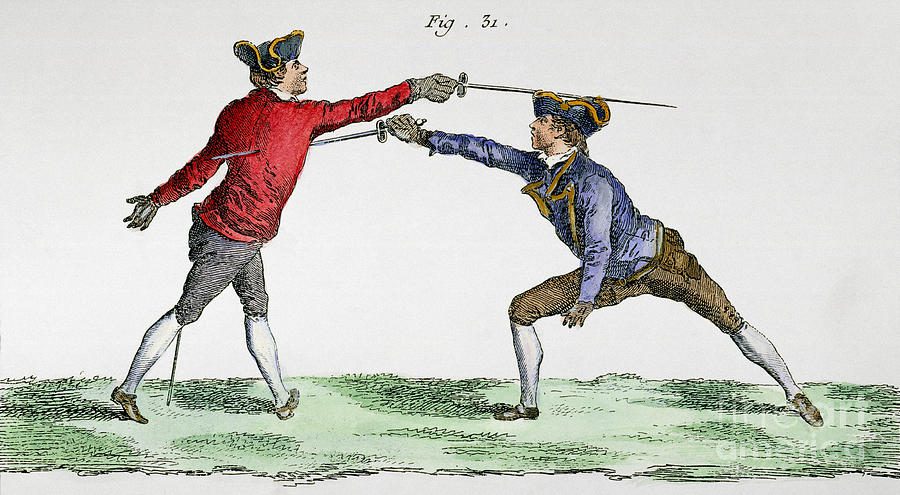The Importance of Dual Meets
*Note-the picture is that of a duel; two teams competing is a dual
Dual meets have mostly disappeared from competitive cross country and track and field on every level.   On the high school level in Maryland, the only leagues that truly have dual meets are the IAAM and MIAA. Racing, on some level, has a negative connotation to it in XC and track. In the NCAA, teams are only required to have four regular season meets for cross country. Many of the top level teams only run their top 7 once or twice during the season, which are large invitationals, then in the post-season. For league meets at the high school level here in Maryland, it is rare for a top level team to run their top seven in a regular season meet, instead saving them for the weekend. Many times, they do not even compete in Maryland. For track, it is the same. League meets during the week are seen as filler meets then the top athletes race at invites, where runners are mostly anonymous since the fields are so large.
While the nature of cross country and track are different than other sports since you can’t have three teams playing soccer at the same time, it is important for the legitimacy of the sport to have competitive, meaningful dual meets that count towards a season standing, where there is a season champion. In no other sport, do the following scenarios or exchanges take place:
“What was the score?”  “I don’t know. It doesn’t matter.”
Coach K does not put his starters in because he is saving them for the weekend.
Coach K doesn’t put his starters in because this game “doesn’t matter” (since there are no standings).
Harbaugh doesn’t start Jackson because he is saving him for the next game.
The training for cross country and distance runners is certainly different than other sports, and it doesn’t follow the trajectory of other seasons, since xc runners are racing for nine months. Still there are ways to include dual meets and not overload runners.
In both track and cross country, dual meets are important to establish and increase competitiveness, develop athletes, and make more meaningful championships.
1. Team Standings and season champions
Every sport should have season standings and cross country and track are no different. For each season, there should be the regular season champion, the county champion, the regional champion, and the state champion. Every other sport is like this. Every game matters. XC is different because there is no bracket for playoffs, but there needs to be a season champion. Then you can say, we were seventh last year, our goal is fifth this year.
2. Establish Rivalries
This is a chance for schools, teams, and individuals to establish rivalries, which are important for sport. Every other sport has rivalries-and they aren’t forced. While the Yankees-Red Sox count the same in the standing as Yankees-Blue Jays, it doesn’t take much guessing for what game you are going to watch. Rivalries bring out the best on both sides.
3. More meaningful championship meets
How often do teams show up to the starting line and they have never raced against the other schools? Teams simply may have never seen each other during the season, or while the schools themselves may have seen each other, one school may have sat their top seven, so effectively, they have not raced against each other. Coaches can go over racing with their teams.  “Suzie beat you in the first race, but Sally beat Suzie last race, and you beat Sally here, so you can be up there with that group.”
4. Smaller race settings for development of athletes
In cross country, the first racing experience for a lot of kids is to line up against 200 other kids from random schools they have never heard of. These kids have no idea how to race, and then some knucklehead, without fail, runs a 22 second 200. The atmosphere of large invitationals is nice and most are well run, but athletes need a chance to truly race and understand racing instead of being in a school of fish.  For track, smaller invites would allow for either additional spots for kids, or there could be 6 events where you get 6 entries.
5. Make Invitational actually be invitationals
At the end of 2019 and the beginning of 2020, track invitationals were anything that required an invitation.  Schools that host meets could now invite teams based on certain characteristics to enhance the competition for all: geography, regionals, certain events, etc…Then meets would be competitive and the standings would matter. The indoor Frostbite meet is an example. It is about 16 teams for boys and girls and takes about 4 hours. As it stands now, invites are a random aggregation of teams. A team can show up to a 40 team invite and just have 3 or 4 good kids and still win the team title. Kudos to the athletes, but that does nothing for the sport.
*There are many invitationals in Maryland for both xc and track that are enjoyable and well run.
Suggestions of what a season would look like
The counties are very unbalanced in terms of schools, so scheduling would be harder for Baltimore and Montgomery County.
Pushing that aside for the moment, a season is about 7-8 weeks long. Have dual meets (really tri or quad meets) every other week. Possibly for a 5th week, you could have a mini invite, where you randomly split the county in half. Then just score out the meets like a dual meet. Use the prior season standings, so that the best teams race at the final meet.
For the past two seasons, during abbreviated competition due to the pandemic, teams have mostly competed in dual, tri, or quad meets. After this year’s graduating class exits, we will have rising juniors, sophomores, and freshmen, many of whom may be unfamiliar with the large style invite. With many schools losing participation numbers, this is a chance to reset and have smaller meets to rebuild programs and competition. Invites are still great and meaningful, but there is no need right now to have big invites, particularly in track, which can take up to 8+ hours.

